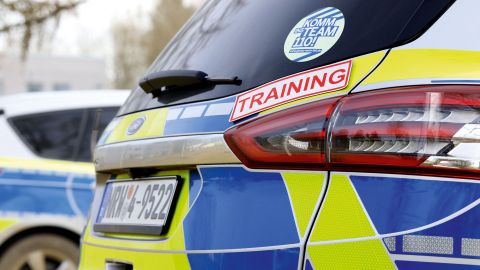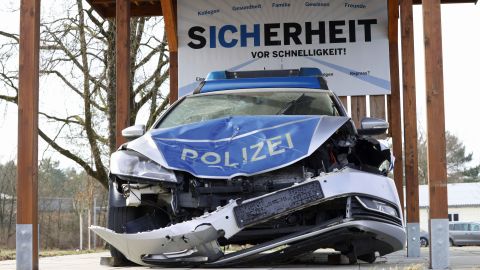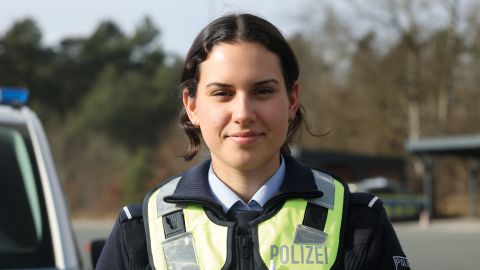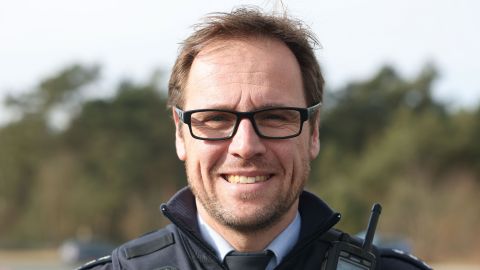First, we carefully turn, maneuver and reverse park. Just the basics. A short slalom to warm up is followed by a dangerous emergency stop in front of a safety beacon. The front wheels of the car have to come to a halt exactly in a rain gutter. A dynamic bend with a so-called bottleneck requires quite a bit of skill for the red and white traffic cones to stop. The seatbelt does its duty during another emergency stop with swerving at higher speeds. After completing a quick U-turn and a longer slalom, you pass large water sprinklers. They make for a really wet ride, and steering and swerving on slippery surfaces becomes a proverbial slippery ride. The expert calls it a μ-jump.
The students in police training have to master this course a total of four times on the grounds of the NRW State Office for Police Training, Further Training and Personnel Matters (LAFP) in Schloß Holte-Stukenbrock. After each lap, the young men and women become more confident. The speed increases, the tires squeal across the training grounds, a bit of the 24-hour Le Mans race is in the air. On the last lap, the stopwatch is running. The best driver of the year in 2025 needed just over 2:30 minutes to complete the circuit on this day in February. The all-time record is still 20 seconds slower. But be careful: every mistake is punished with a hefty time penalty. After all, the same applies here as in the entire driving training for trainee inspectors: safety comes before speed.
The driving and safety training is an important part of the dual course of study for the higher service of the NRW police, which around 3,000 students start every year on September 1. "For this training, which takes place at the LAFP locations in Brühl, Schloß Holte-Stukenbrock and Selm, there are a total of four modules on the training schedule, one of which is part of the foundation course and three of which are part of the advanced course," explains Stephan Bockting (48), who heads up training department 43 of the LAFP NRW in East Westphalia. All in all, this adds up to more than 50 hours behind the wheel.
Laura Brkic has just completed the first two laps of the course. "Of course, I already knew how to drive beforehand. But now I drive much more consciously, as I have experienced what happens to my vehicle on slippery roads, for example, or how I can take evasive action in the event of sudden danger," emphasizes the 21-year-old, who, like her fellow trainees, is in her second year of training (i.e. already in her main course of study). When emergency braking, for example, the following applies: "Stay nice and relaxed at the top and hit the brakes with full force at the bottom." Laura Brkic: "As I'm sure that I'm capable of dealing with danger if the worst comes to the worst, I'm much less stressed on the road."
It is undisputed that it takes far more than a regular driving license to drive a patrol car quickly and carefully in traffic under operational conditions. "Police officers are exempt from parts of the road traffic regulations when they are on patrol - but not from physics," emphasizes Senior Police Officer Bockting. To this end, the modules in the basic course are practiced on the respective training location's premises, while the main course involves driving in normal road traffic. Naturally with Mercedes Vito and Ford SMax, i.e. with the models that are also on the road in everyday police work. These trips add up to quite a few kilometers.
The students experience particularly challenging situations with us at their side during the training drives, especially under operational-like conditions, and not only when there are actually explosive situations on duty. In this way, we prepare them for the real world in the best possible way and at the same time strengthen the road safety of everyone involved," says Chief Superintendent Tobias Jany. The trained motor vehicle mechatronics technician and driving instructor has been teaching his trainees what he calls "tactical driving" for more than ten years.
"The urge to help quickly is understandable. The urge to speed dominates everything in such cases, but it must always be subordinated to road safety," says Jany. "It doesn't help anyone if we don't get there. We are not invulnerable - and neither are the other road users." The broken radio patrol car, which stands as a memorial on the LAFP site in Schloß Holte-Stukenbrock, makes this more than clear every day (see left margin column).
The 48-year-old is one of around 240 of the more than 400 LAFP instructors who have completed special courses in driving and safety training. Like Isabel Kreimeier, who has been part of the team for six years. "We teach more conscious driving than is shown in traditional driving school," says the 30-year-old government employee.
Angelo Campagna is currently completing his dual studies with the NRW police. "I've had my driver's license for more than a decade, but we're driving on a completely different level here," says the 30-year-old. "I drive more confidently, but that doesn't necessarily mean that I drive faster." He is aware that he has a special responsibility at the wheel of a patrol car.
The man from Lippstadt then demonstrates this knowledge, this new "driving skill", in his training car. First, the low-speed driving area awaits again with turning, maneuvering and parking. During emergency braking, the wheels stop right in the groove. A precision landing in other words.




